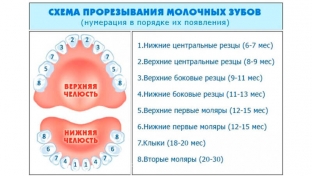Teething is a physiological process and an indicator of a child's development. The process of tooth growth in a child depends on the state of health and the level of metabolism, as well as the presence of certain diseases. So, a long delay in teething in children can be a consequence of impaired functioning of the intestine, rickets, an infectious disease, as well as metabolic changes. Early teething indicates the presence of endocrine pathologies. At what time does the eruption of milk teeth occur? What deviations are possible and what is their reason?
What is the order of eruption of milk teeth?
At birth, a normal child does not have a single tooth. The process of eruption of milk teeth begins after six months. Between 6 and 8 months, the child begins to grow the central incisors in the lower jaw, later the incisors grow in the upper jaw. Between 8 and 12 months, the lateral incisors erupt on the lower jaw, then on the upper jaw. Between 12 and 16 months, the first molars erupt. Canines begin to grow after 16 months and up to 20. After 20 months and up to 30 months, the second molars grow. They also complete the formation of the bite of milk teeth in a child.
In infants, development is often measured by the number of teeth that have erupted. This is not entirely correct, since the timing of the appearance of teeth in children is individual and may vary. For example, the first tooth may begin to grow as early as 1 month of age, sometimes this happens at the age of 1 year, which is not a pathology. Most often this happens at 6-8 months. But all organisms are individual, have their own terms. On average, a baby who is one year old has 8 teeth.

Signs of physiological eruption of milk teeth:
- the eruption of milk teeth must occur in a certain order;
- teeth erupt in pairs;
- teeth erupt at certain times.
Possible changes in the condition of the teeth after the eruption of milk teeth
At the age of 7, milk teeth are replaced by permanent ones. First, the central incisors grow, which corresponds to 9 years, the first premolars grow in the next year of life, and the canines grow a year later. Further, the second premolars grow, by the age of 12-13 – second molars. But the third molars of the lower and upper jaws, which are popularly called "wisdom teeth", grow later, after 20 years.
Peculiarities of teeth in children during the eruption of milk teeth, their causes:
- Black edging on the neck of the tooth may be due to the use of iron preparations or as a result of an inflammatory chronic process caused by leptotrichia in the oral cavity.
- An increase in the gaps between the teeth occurs against the background of increased growth of the jaws during the transition of milk teeth to permanent ones. This is considered normal. The presence of a wide gap between the anterior incisors in the upper jaw, as a rule, is due to the presence of a deeply located frenulum of the upper jaw. Such a child should be under the supervision of an orthodontist.
- The presence of yellow-brown staining of teeth in a child appears against the background of the use of antibacterial drugs by the mother during pregnancy in the second half of pregnancy or by the child during the formation and eruption of milk teeth.
- Yellow-green coloration of the teeth develops in severe disorders of bilirubin metabolism, as well as in hemolytic conditions.
- Incorrect bite formation occurs against the background of uneven growth of the jaws, with prolonged use of the nipple by the child.
- Red staining of teeth occurs with congenital disorders of the metabolism of the porphyrin pigment.
- Incorrect positioning of the teeth may be due to the small size of the jaws, as well as tumors of the connective tissue and the alveolar process of the jaw, which affects the eruption of milk teeth.
Absence of eruption of milk teeth during the first year of life is rarely associated with adentia. It is possible to detect the presence of tooth germs using a special method of radiovisiography.







Add a comment